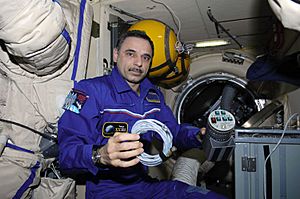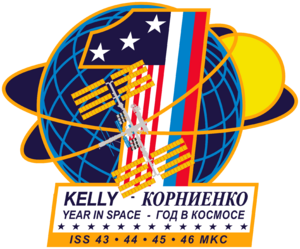Mikhail Kornienko facts for kids
Quick facts for kids
Mikhail Kornienko
|
|
|---|---|
 |
|
| Born | 15 April 1960 Syzran, Kuibyshev (Samara) Region, Russian SFSR, Soviet Union
|
| Status | Retired |
| Nationality | Russian |
| Other names | Mikhail Borisovich Korniyenko |
| Occupation | Engineer |
| Space career | |
| Roscosmos cosmonaut | |
|
Time in space
|
516d 10h 1m |
| Selection | 1998 Cosmonaut Group |
|
Total EVAs
|
2 |
|
Total EVA time
|
12 hours, 13 minutes |
| Missions | Soyuz TMA-18 (Expedition 23/24), Soyuz TMA-16M/Soyuz TMA-18M (Expedition 43/44/45/46, ISS year-long mission) |
|
Mission insignia
|
 |
Mikhail Borisovich Kornienko (Михаил Борисович Корниенко; born 15 April 1960) is a Russian cosmonaut who has flown on several missions to the International Space Station (ISS).
He first worked as a flight engineer during Expedition 23 and 24 in 2010. Later, Kornienko was chosen for a special year-long mission on the ISS. This mission lasted from March 2015 to March 2016. He worked with American astronaut Scott Kelly on this long trip. The mission, which started aboard Soyuz TMA-16M, aimed to study how long periods in space affect the human body and mind. The information gathered helps prepare for future space missions that will last a very long time.
Contents
About Mikhail Kornienko
Early Life and Family
Mikhail Kornienko was born in Syzran, a city in Russia. He is married to Irina Kornienko, who is a doctor. They have a grown daughter. His father, Boris G. Kornienko, was a military pilot who passed away in a helicopter crash in 1965. His mother, Faina M. Kornienko, was born in 1931 and is now retired.
Education and Early Career
Kornienko finished high school in Chelyabinsk, Russia, in 1977. After school, he worked at a radio equipment factory. In 1978, he joined the Soviet Army and served in the Airborne Forces. He finished his military service in 1980.
From 1980 to 1986, Kornienko worked for the Moscow Police. At the same time, he studied at the Moscow Aviation Institute. He graduated in 1987 as a mechanical engineer, specializing in rocket engines. After leaving the police, he worked at a design bureau. From 1986 to 1991, he was a specialist for launch equipment at the Baikonur Launch Facility.
In 1995, Kornienko began working at the Energia Rocket Space Corporation (RSC Energia). Here, he helped create technical documents for cosmonaut training. He also took part in tests for extravehicular activity (EVA), which are spacewalks. These tests were done in special pools that simulate zero-gravity. This work helped him learn how to organize repairs and assembly tasks outside the Mir space station.
Becoming a Cosmonaut
On 24 February 1998, Mikhail Kornienko was chosen as a test cosmonaut candidate. After completing his basic training in 1999 at the Yuri Gagarin Cosmonaut Training Center, he officially became a test cosmonaut. Since then, he has trained with the International Space Station group. He was a backup flight engineer for the ISS Expedition 8 crew. He also served as a backup flight engineer for the Soyuz TMA-10 and Expedition 15 missions in 2005.
Space Missions
First Trip to Space: Expedition 23/24
Kornienko's first journey to space was as a Flight Engineer for Expedition 23 and 24. He launched on 2 April 2010, with Russian cosmonaut Aleksandr Skvortsov and NASA astronaut Tracy Caldwell-Dyson. They lifted off aboard Soyuz TMA-18 from the Baikonur Cosmodrome.
After completing Expedition 24, the Soyuz TMA-18 spacecraft, carrying Kornienko, Skvortsov, and Caldwell-Dyson, undocked from the space station on 24 September 2010. They landed safely in Kazakhstan on 25 September.
After returning to Earth, Kornienko shared his feelings. He said that what he missed most in space was Earth itself. He missed smells, trees, and even dreamed of them. He even imagined smelling a real fire and barbecue! To feel better, he put pictures of trees on the walls of the station.
Spacewalks on Expedition 23/24
On 27 July 2010, Kornienko and fellow Russian cosmonaut Fyodor Yurchikhin performed a spacewalk outside the ISS. Days before, they practiced in their Orlan spacesuits to make sure everything worked.
During their spacewalk, Kornienko and Yurchikhin worked on the Rassvet module. They installed cables and replaced a video camera. The spacewalk began at 04:11 UTC. It was the 25th Russian spacewalk from the station. At one point, they accidentally lost a small object, possibly a fixture for cables. Later, another small item, like a washer, floated away. The spacewalk lasted six hours and 42 minutes.
The Year-Long Mission on ISS
In November 2012, NASA, the Russian Federal Space Agency (Roscosmos), and their partners chose two experienced space travelers for a one-year mission on the International Space Station. This mission was important for collecting scientific information to help with future human exploration of the Solar System. NASA selected Scott Kelly, and Roscosmos chose Mikhail Kornienko.
Kelly and Kornienko launched aboard a Russian Soyuz spacecraft from the Baikonur Cosmodrome in Kazakhstan in March 2015. They landed back on Earth on 1 March 2016. Kelly and Kornienko already knew each other; Kelly had been a backup crew member for the Expedition 23/24 crews, where Kornienko was a flight engineer.
The main goal of their year-long stay in space was to understand how the human body reacts and adapts to living in the harsh environment of space for a long time. The information from this 12-month mission helps scientists understand how astronauts perform and stay healthy. It also helps them find ways to reduce risks for future missions, especially as NASA plans journeys around the Moon, to an asteroid, and eventually to Mars.
Film Appearance
In 2016, Mikhail Kornienko and Andrey Borisenko appeared as themselves in the comedy film Yolki 5.
Images for kids
See also
 In Spanish: Mijaíl Korniyenko para niños
In Spanish: Mijaíl Korniyenko para niños




